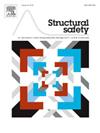Bayesian active learning methods have emerged for structural reliability analysis and shown more attractive features than existing active learning methods. However, it remains a challenge to actively learn the failure probability by fully exploiting its posterior statistics. In this study, a novel Bayesian active learning method termed ‘Parallel Bayesian Probabilistic Integration’ (PBPI) is proposed for structural reliability analysis, especially when involving small failure probabilities. A pseudo posterior variance of the failure probability is first heuristically proposed for providing a pragmatic uncertainty measure over the failure probability. The variance amplified importance sampling is modified in a sequential manner to allow the estimations of posterior mean and pseudo posterior variance with a large sample population. A learning function derived from the pseudo posterior variance and a stopping criterion associated with the pseudo posterior coefficient of variance of the failure probability are then presented to enable active learning. In addition, a new adaptive multi-point selection method is developed to identify multiple sample points at each iteration without the need to predefine the number, thereby allowing parallel computing. The effectiveness of the proposed PBPI method is verified by investigating four numerical examples, including a turbine blade structural model and a transmission tower structure. Results indicate that the proposed method is capable of estimating small failure probabilities with superior accuracy and efficiency over several other existing active learning reliability methods.


